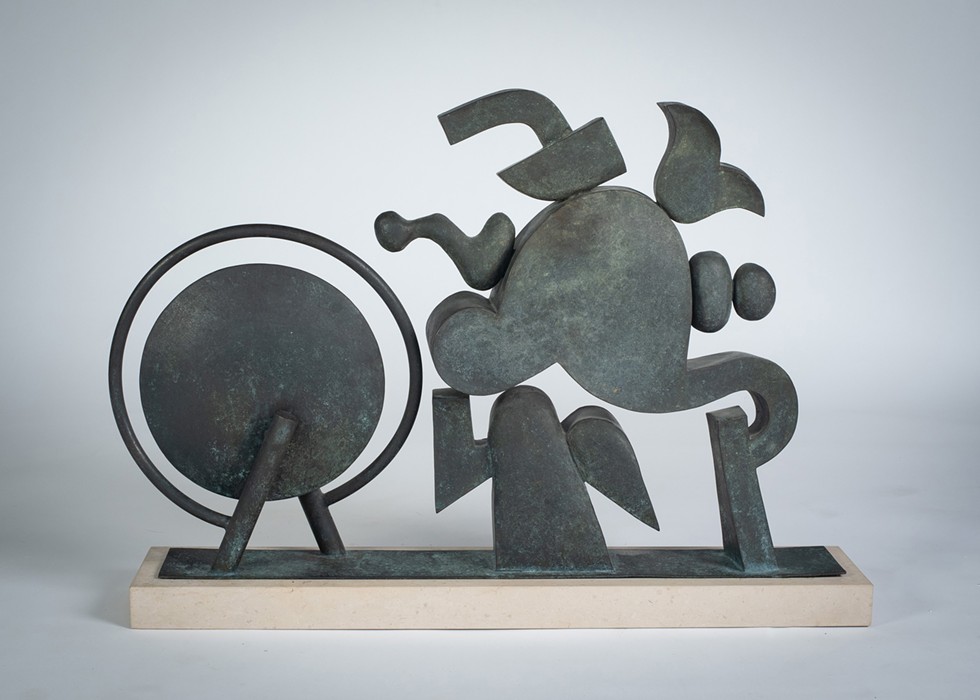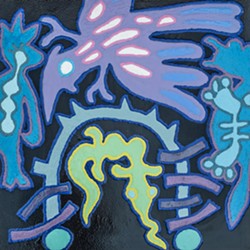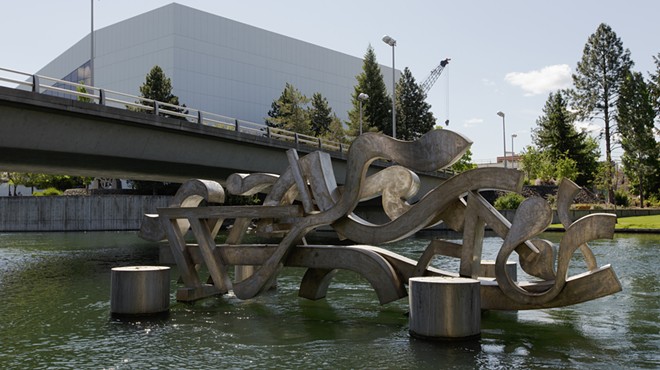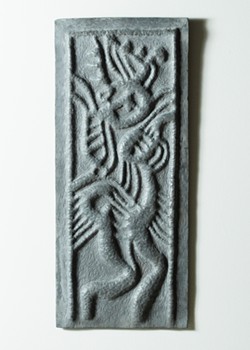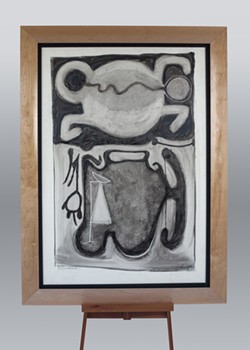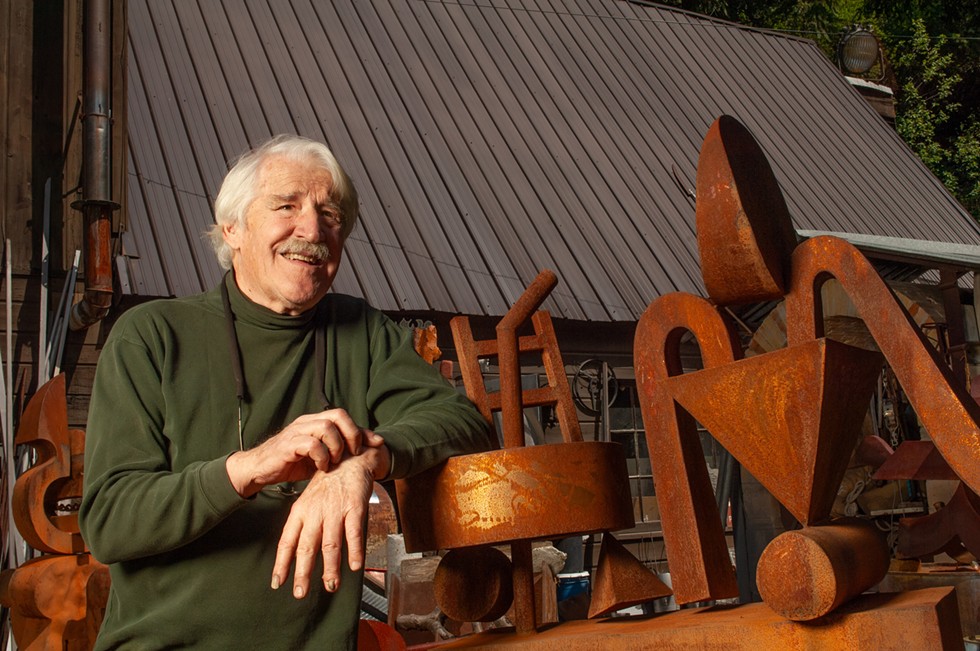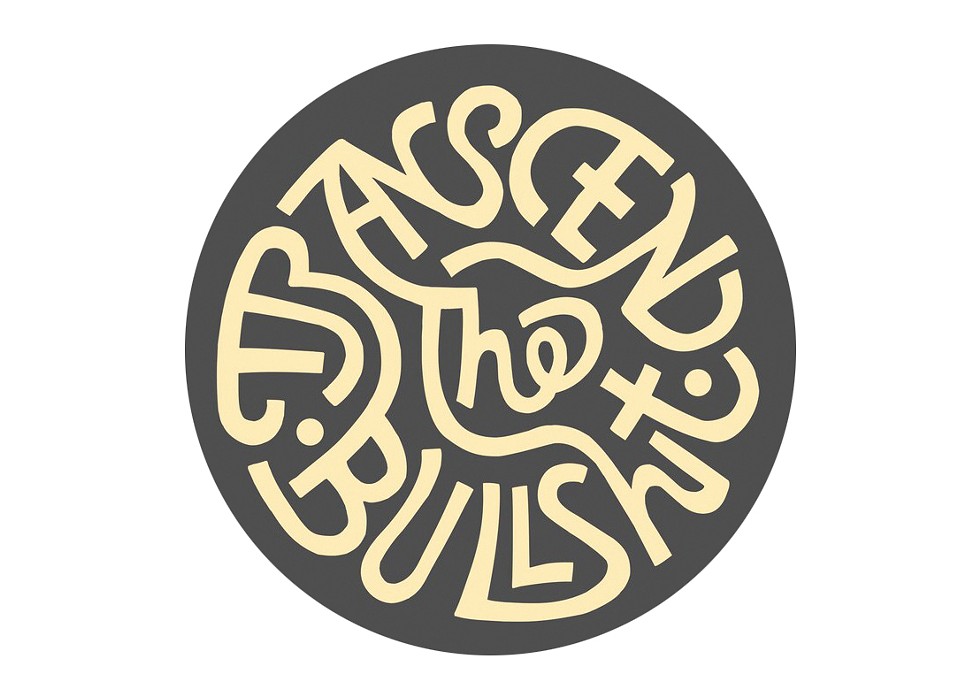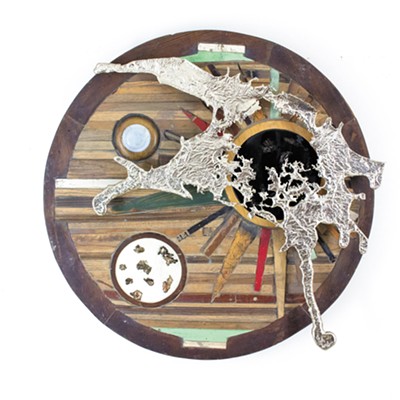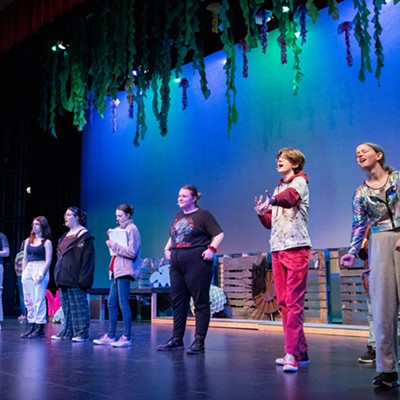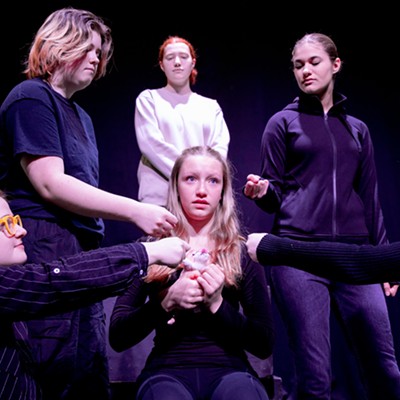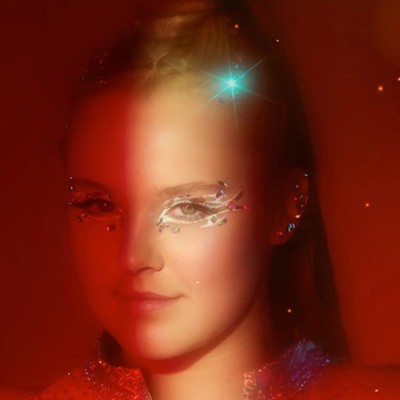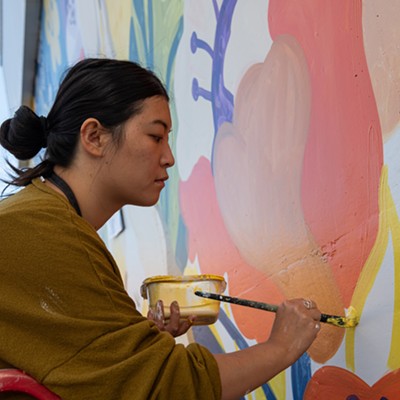Even if you don't think you know Harold Balazs' artwork, you've probably experienced it if you've spent any time in and around Spokane, where the artist lived and worked for nearly seven decades before his death in 2017.
Maybe you've splashed in Riverfront Park's Rotary Fountain, which Balazs co-created in 2006, or smiled at the "hidden" message atop his Expo-'74-era tower outside First Interstate Center for the Arts known as "The Lantern." Was a Balazs sculpture part of your daily high school routine at Ferris, Lewis and Clark, or Mt. Spokane? Or maybe you've spent a quiet moment amid the many Balazs' works at local places of worship, such as the Unitarian Universalist Church.
Everywhere you look in Spokane, you're likely to find a connection to the famously prolific, mustachioed artist whose accolades include the Washington state Governor's Arts and Heritage Award (1988) and the most frequently voted "best local artist" in the Inlander's annual Best Of readers poll.
While walking through Kendall Yards recently, Kayla Tackett, the director of exhibitions and collections at the Northwest Museum of Arts and Culture, was delighted to recognize a Balazs' sculpture — an abstract metal piece titled "Mixed Forms." (The sculpture is located on West Summit Parkway in front of the Yards Bruncheon.)
"I'm always kind of fascinated with how you start to get to know an artist's work and then you see a piece by them, and you know it's by them," says Tackett, who has spent a lot of time getting to know Balazs' work in preparation for "Harold Balazs: Leaving Marks," an eclectic collection of his artwork featured at the MAC from Feb. 3 through June 2.
The exhibition features 30 artworks in the process of being purchased from a private collection, and thus never shown together. Nor have many of the works recently been in the public eye.
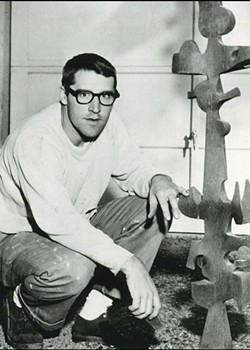
The show is not a retrospective, but rather a kind of snapshot of a time in Balazs' life, says Anne-Claire Mitchell, founder of Spokane's former Richmond Art Collective and an independent curator who has worked with the MAC in the past.
Typically a curator would choose specific works to feature, but because the new Balazs exhibition showcases an existing collection of pieces, Mitchell's focus was different.
One of her curatorial goals has been to "create an experience that was going to be sentimental, especially for folks who knew Harold and knew his work," she says.
"It's been a fun challenge, actually, to be able to look at the collection as a whole in its current unedited form and be able to interpret some things about Harold's life and his character and what he believed in and the way that he was working," Mitchell says.
Supplementing the 30 artworks will be some of Balazs' sketchbooks, as well a digital reproduction of a large 2008 print titled "Autobiography 80th Year." The monochromatic, black-and-white "Autobiography" consists of roughly eight rows of symbols which may refer to, but are by no means a decoder, of Balazs' vast library of recurring and evolving motifs.
"The idea was to orient visitors to the space and to Harold's visual language with that print, because it gives us kind of an idea of the forms and the shapes and the remixing of archetypal forms that he was developing over the course of his life," Mitchell says.
By all accounts, Balazs' influences were as much about aesthetics and design as they were craftsmanship and construction. Born in Ohio in 1928, he was exposed to both at a young age, with art classes at the Cleveland Art Museum and time spent working in his father's sheet metal shop. When his parents relocated to Spokane in 1947, Balazs' followed, eventually earning a degree from Washington State College (now called Washington State University).
By the mid-1950s, Balazs had married, started a family and begun what would be a long and varied career as an artist, often collaborating with other like-minded entrepreneurial types — from his wife, Rosemary, to nationally known ceramicist Rudy Autio, for example.
Balazs' enameled copper and silver jewelry sold well, and as word spread about the innovative artist who perfectly synthesized craftsmanship with creativity, his reputation and list of commissions grew. Balazs' smaller enamels evolved into larger ones like those that embellish Spokane's St. Charles Catholic Church. His innovative collaborations with area architects earned him a gold medal from the American Institute of Architects in 1967.
Although he was formally educated in art, Balazs' never stopped learning, whether that was a workshop in Australia, a foray into the Alaska wilderness with artist friends or his grandson, or teaching himself some new technique he might employ in his quest to "create wonder."
"Harold Balazs: Leaving Marks" showcases the artist's diverse ways of working, from three-dimensional, low relief and freestanding sculpture to mixed-media drawings, as well as enamels, an artform for which Balazs received considerable acclaim.
In 2001, Balazs was recognized by the Enamelist Society for his pioneering work and excellence in enameling, which involves coating a metal surface with powdered, colored glass and superheating it so that the glass particles fuse with the metal. This technique is on display via the vibrant panels titled "Birds of the Northwest" and "Northwest Wildflowers" gracing the exterior of Spokane's Lincoln Building on West Riverside Avenue.
Four enamels in the exhibition offer the only color in the collection, which is otherwise monochromatic.
"It's not the most typical of Harold's work in some ways," says his daughter Erika Balazs, who's partial to his more colorful work, including his enamels, watercolors, silkscreens and painted wood sculptures.
Even though she's familiar with much of her father's ways of working, there are some pieces in the MAC's new showcase that she doesn't remember seeing before.
"That whole series of the black-and-white and grayish drawings?" says Erika. "I don't remember those at all."
"He made a lot of stuff," she adds with a laugh, echoing Balazs' oft-quoted use of the vernacular: "Making stuff is better than not making stuff."
One of those monochromatic pieces in the collection is a 12-foot-long drawing. Because it lacks a title and owing to its subdued palette, abstract imagery and size, Tackett and others on staff have nicknamed it "Harold's Guernica" (after Spanish painter Picasso's "Guernica").
Indeed, there are plenty of similarities between the two artists. Balazs' may have had Picasso in mind while producing some of his early works in the 1950s and '60s, including a painting the MAC already owns.
While a student at Washington State, Balazs painted "Ladies Day," a small ink wash that is reminiscent of Picasso's paintings of female figures. In 1991 Balazs and Rosemary gifted "Ladies Day" to the museum, which already has nearly 40 of the artist's mostly two-dimensional work including paintings, prints and drawings.
Nineteen years later, in 2010, the MAC organized a retrospective of Balazs' work. It was accompanied by a University of Washington Press hardcover publication, which included a more direct connection between Spokane's favorite artist and Spain's native son: Balazs' 1960s aluminum sculpture titled "Homage to Picasso."
Like Picasso, Balazs worked in a wide variety of media, initially enameled copper and silver jewelry, but also printmaking, painting and drawing.
Throughout his career, Balazs employed a variety of sculptural materials, including numerous wood species and types of metal in both flat and three-dimensional works. For example, he cut and welded stainless steel, similar to the Riverfront Park sculpture floating in the river that commemorated Spokane's centennial in 1981.
HAROLD BALAZS: LEAVING MARKS
WHEN: Feb. 3 through June 2; open Tue-Sun from 10 am-5 pm (third Thursdays until 8 pm)ADMISSIONS: $8-$12 (free to members and children 5 and under)
WHERE: Northwest Museum of Arts & Culture, 2316 W. First Ave.
MORE INFO: Northwestmuseum.org, 509-456-3931
In addition to several stainless steel pieces in the exhibition, the collection includes several unique low-relief panels made from lead, as well as several formed copper pieces — "Poised," "A Dialogue," "Small Being" — that could be maquettes or studies for larger works, measuring only a couple feet across.
Measuring 4-by-8-feet, "Trying to Understand" is a low relief panel of cut and modeled styrofoam coated in lustrous gray-black graphite that, to Mitchell, resembles a stone slab. Compared to metal, styrofoam is much lighter and could be cut, carved and even used in casting, all methods Balazs pioneered.
"I think that it's a nice work to talk about for this show just because it has a little bit of everything," Mitchell says.
"It showcases some of the archetypal forms that [Balazs] was working with. It tells a story of how he started using styrofoam as a sculptural material that kind of evolved out of his pioneering styro-casting and concrete forming technique. And it's just an experimental way of working with affordable materials and making something thought provoking or awe inspiring."
Like roughly a third of the works in the exhibition, "Trying to Understand" lacks a date. Other works have no title. That's not unusual for Balazs, however, especially given his prolific output of work over 60-plus years.
In the book accompanying his 2010 MAC exhibition, Balazs included the following disclaimer, which reads in part: "making things and images was my work. When I made them, how big they were, where they went, and what was their name were also of no interest to me. So please forgive the unavailable provenance of much of my endeavor."
What mattered to her father, says Erika, was making artwork and ensuring that it was available to the public. That included pricing his art so it was affordable, such as at the museum's annual ArtFest, which Balazs participated in since its inception in 1985, as well as at the Art Spirit Gallery, which has represented Balazs since 1997.
"What I think is exciting is, Dad wanted art accessible, and this is now going to be a bunch of art that's accessible to a lot of people" by being at the MAC, she says.
"And the other thing I'm really hopeful of is that all those people in town who have Harold Balazs' work they've collected, whose kids may not want it, or it might not fit in their [space], and they don't know what to do with it, I'm very hopeful that this will spark a rash of donations of art to the museum." ♦
This article has been updated to better describe Anne-Claire Mitchell's involvement with the MAC.
TRANSCEND THE WHAT?
There are many common themes throughout Harold Balazs’ body of work: the use of geometric shapes, motifs of the natural world and, of course, Transcend the Bullshit.You’ve probably seen the stylized phrase on mugs, T-shirts, hats, belt buckles and, hell, even tattooed on the arms of locals. The logo even serves as an Easter egg on some of Balazs’ work. The metal sculpture he did for North Idaho College (“I Must Go Down To The Seas Again”) has the phrase carved into it.
Perhaps most famously, it's carved into the top of Balazs’ 1974 sculpture “Lantern,” which is on the Centennial Trail between the Spokane River and the northwest corner of the First Interstate Center for the Arts. In the past, it was a feat to have climbed the geometric sculpture and discovered the artist's hidden phrase. (Note: Climbing the sculpture is illegal, please just take our word for it.)
Balazs created a stylized, circular poster of the saying (which he borrowed from Ken Kesey) in the 1960s that became an iconic logo, printed on mugs at Atticus (thanks to previous owner, Andy Dinnison) and posters at Chris Bovey’s Vintage Print + Neon store in the Garland District.
It’s a good motto to live by, Transcend the Bullshit. Maybe we should all take a page out of Balazs’ book and rise above it all. Just don’t climb the sculpture.

